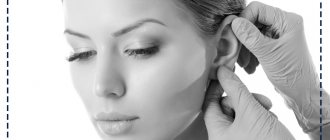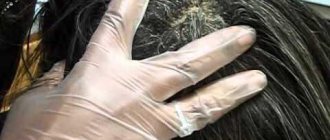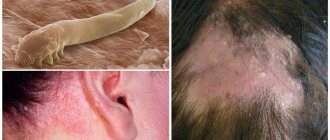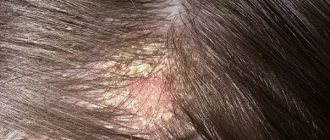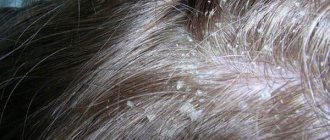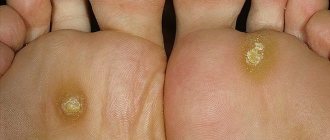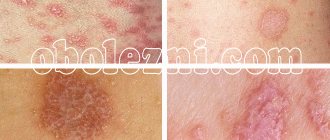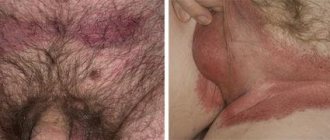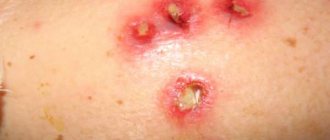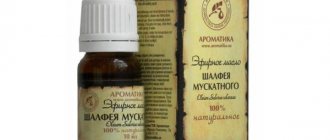The mechanism of sweat glands
Hyperhidrosis is a physiological phenomenon in which the body produces excess water on the skin. Increased sweating ensures normalization of body temperature under the influence of environmental factors (increased physical activity, development of infectious diseases).
The sweat released cools the skin and prevents metabolic disorders that can disrupt normal vital processes in the body. If these symptoms are permanent, then it is necessary to identify the cause of the discomfort and prescribe the correct treatment regimen.
Features of the functionality of sweat glands:
- There are more than 4 million sweat glands in the human body, which secrete a colorless, transparent liquid and are classified as eccrine type.
- Eccrine sweat glands in the face and head are mainly located on the cheeks and frontal area,
- In hot weather and intense physical activity, a person can lose up to 10 liters of fluid per day,
- The activity of the eccrine sweat glands is controlled by the sympathetic nervous system, the brain stem (hypothalamus).
How does hyperhidrosis of the head and face manifest?
This type of excessive sweating is called craniofacial hyperhidrosis. This disease is characterized by the release of large volumes of sweat from the sweat glands located in the scalp, temples, neck, forehead, and sometimes the cheeks or nasolabial triangle. During sweating, patients often feel hot, the skin turns red and becomes covered with perspiration and visible drops of sweat; attacks of hyperhidrosis are also often accompanied by increased excitability and emotional stress. With a long course of the disease, an unpleasant odor may appear, the cause of which is the substances contained in the secretion of the sweat glands, as well as waste products of bacteria that quickly multiply on the surface of damp skin.
Most often, the trigger for intense sweating for patients with hyperhidrosis is a stressful situation - an unpleasant conversation, interview or meeting, or other action associated with psycho-emotional stress. Increased sweating also occurs in other situations, for example, during physical activity or in a hot room, but in these cases it is understandable and does not cause such discomfort. Knowing about this feature of his body, the patient begins to get nervous long before the onset of a stressful situation, and worries not only about what caused it, but also about how he looks in the eyes of others. This naturally leads to even more sweating. A vicious circle is formed - in order to break it, in some cases it is necessary to resort not only to medications and physiotherapy, but also to psychotherapeutic methods of treatment.
The result of long-term and severe hyperhidrosis is often a change in character, the formation of phobias and fears: people suffering from this disease become more withdrawn, irritable, have difficulty establishing contacts with other people, often suffer from social maladaptation and may experience problems in their professional activities, especially if it is closely related to communication and public speaking. The self-esteem of such patients decreases, the level of motivation and vitality drops.
What is hyperhidrosis
Hyperhidrosis does not imply an increase in the number of sweat glands or their size. A distinctive feature is the increased secretion of sweat. Heavy sweating in women is characterized by the active functioning of the sympathetic nervous system and the presence of a genetic predisposition.
Eccrine sweat glands begin to actively produce sweat in severe stressful situations, as the level of adrenaline rises in the blood and provokes increased sweating.
Hyperhidrosis of the face and head is often inherited. This factor is explained by the presence of a predisposition in the body. If such dynamics are observed in the father or mother, then the risk of developing this pathology in the child is high.
Medication to get rid of the problem
Mild to moderate degrees of excessive sweating can be treated with medication.
Hyperhidrosis begins to be treated by taking sedatives and reducing emotional stress of synthetic or natural origin. Preparations of valerian, mint, motherwort, passionflower, and a complex plant-based remedy Persen are used.
Among sedatives, bromine preparations are used - sodium or potassium bromides, camphor bromide, ammonium bromide (Propantheline). If sedatives do not have the necessary effect, tranquilizers are used, with the help of which they normalize the functional activity of the nervous system and eliminate autonomic symptoms of anxiety.
To treat hyperhidrosis, belladonna or belladonna vulgaris preparations are often used. Such products can be used by patients over 18 years of age.
Mainly used:
- Bellaston. Suppresses the functions of sweat and apocrine glands;
- Belloid. Treats neuroses, vascular spasms and disorders of the autonomic nervous system that provoke hyperhidrosis;
- Bellantaminal. Reduces irritability of menopausal nature.
If hyperhidrosis is accompanied by malnutrition, hypotension, and neuroses, the biogenic drug Apilak is prescribed, which has an antispasmodic, restorative and restorative effect.
To treat hyperhidrosis, anticholinergic drugs are used that block the neurotransmitter acetylcholine. This includes:
- alkaloids – Atropine, Scopolamine;
- antihistamines – Promethazine;
- medications for the treatment of Parkinson's - Trihexyphenidyl, Benzotropine.
Effective treatments for sweating of the face, hands, feet and armpits are Atropine, which inhibits the sweat glands, and Oxybutin (the drug is recommended for use in elderly patients).
Drug treatment of hyperhidrosis after menopause is associated with stabilization of hormonal balance. During this period, women complain of “hot flashes,” most often the face and upper body become covered in sweat. Complex therapy in this case includes sedatives, and the use of certain herbal remedies is also recommended:
- Climandon. Reduces the frequency of hot flashes;
- Feminala. Effective for hypersecretion of axillary sweat glands;
- Femilaxa. Facilitates the course of hot flashes, reduces sweating in the armpit area.
Herbal medicines are harmless, have a cumulative property, and can be combined with various methods and medications to combat hyperhidrosis.
To reduce sweating, it is recommended to use medical antiperspirants “Maxim”, “Odoban”, “DryDry”, “Drisol”.
Reasons for appearance
Hyperhidrosis of the face and head can occur for a number of specific reasons, which are presented in the list below:
- Disturbance of the normal functionality of the thyroid gland,
- Negative consequences after concussion or severe concussion,
- Diseases caused by metabolic disorders
- Infectious diseases
- Abuse of bad habits (alcohol, cigarettes),
- Pregnancy period
- Various allergic reactions in the body,
- Presence of traumatic brain injury
- Side effects from taking certain medications
- Poor nutrition, poisoning,
- Severe intoxication of the body,
- Development of the oncological process,
- Having excess weight
- Disturbance of metabolic processes in the body,
- Disruption of the endocrine system (diabetes mellitus),
- Diseases of a dangerous nature (AIDS, HIV, lymphogranulosis, hypoglycemia, tuberculosis),
- Changes in hormonal levels during menopause or puberty,
- Severe nervous disorders and development of neurosis.
Excessive sweating is considered normal when playing sports, intense physical activity, or high temperatures indoors or outdoors.
Excessive sweating in young children is the limit of the norm, since the growing body undergoes constant changes, and the normal functioning of the sex glands is fully formed by the age of five. In this case, hyperhidrosis can develop under the influence of various external factors (improper care, high room temperature, hypothermia).
The development of diffuse sweating (spread throughout the body) implies the presence of possible diseases in the child’s body, which require immediate diagnosis and appropriate treatment.
Hardware method for treating sweating
Physiotherapeutic procedures are often used to treat hyperhidrosis. Electrophoresis and iontophoresis are popular.
Electrophoresis is a device with electrodes, under the influence of an electric field of which the necessary substances are distributed throughout the body through the skin. Effective in the treatment of hypererhidrosis of the head and face.
Iontophoresis is carried out using a drionic - a portable physiotherapeutic device. Warm water is poured into the cuvettes of the device with aluminum plates, and felt pads are placed on top. Under the influence of current, aluminum ions penetrate the ducts of the sweat glands and block the release of sweat. It takes 10 sessions, then once a week to maintain the effect.
Botox (Dysport) injections are also used to block the sweat glands. The procedure takes 30 minutes, the effect lasts 6 months.
Types of disease
Hyperhidrosis of the head is classified as increased sweating of a local nature, since the secreted fluid appears in one area of the body. In this case, sweat may be released in other parts (cheeks, forehead, neck), which indicates a diffuse spread of the pathology.
Excessive sweating of the head is called cranial hyperhidrosis, and facial sweating is called facial hyperhidrosis. In combination, these two phenomena are considered craniofacial hyperhidrosis. This pathology has a clearly defined clinical picture:
- Sweating in large quantities,
- Copious amounts of fluid in the head, face, nose, cheeks, armpits,
- The appearance of intense heat
- Possible redness of the skin,
- Increased nervousness in the patient
- An unpleasant odor of sweat, which is caused by the successful proliferation of pathogenic bacteria.
The following types of increased sweating are distinguished:
- Primary (essential) hyperhidrosis, which occurs without an exact cause and is often inherited. Signs appear at any age, but are usually noted from early childhood,
- Secondary hyperhidrosis arising under the influence of any disease,
- Constant sweating, which does not depend on external factors,
- Seasonal hyperhidrosis occurs when the season changes (spring, summer), since when the temperature rises, the sweat glands begin their active activity,
- Intermittent hyperhidrosis accompanied by periods of increased sweating and frequent exacerbations.
The volumes of liquid released have varying intensity from light perspiration to strong sweat dripping in large drops. In combination with this phenomenon, redness of the skin is often observed, and hyperhidrosis manifests itself in a symmetrical form on both sides.
Content
- Kinds
- Causes of primary facial hyperhidrosis
- Causes of secondary hyperhidrosis
- Treatment
Since increased sweating can be normal (occurs due to overheating, increased physical activity, etc.), facial hyperhidrosis is spoken of only in cases where increased sweating is not associated with the influence of objective factors.
Which doctor should I contact?
Severe hyperhidrosis of the face and head is a rather unpleasant phenomenon that significantly complicates a person’s life. In case of acute symptoms, it is necessary to contact an endocrinologist and take tests to determine the ratio of hormones in the body.
If suspicious symptoms are added in combination with increased sweating, then you must first contact a therapist, who will examine the patient and refer him for the necessary tests or to a specialized specialist.
In some cases, hyperhidrosis of the face and head occurs due to a disorder of the nervous system, so in this case a consultation with a neurologist is required. Accurate diagnosis depends on completing all prescribed tests.
Diagnostics
Diagnosis and identification of the cause of increased sweating is based on the use of the following methods:
- Examination and questioning of the patient to clarify the detailed circumstances of the manifestation of increased sweating (age of onset, main factors of occurrence, preventive measures taken, visual assessment of the general condition),
- Carrying out a starch test with Lugol's solution. The required area of the product is treated with the preparation, and then starch is applied on top and the color intensity is monitored (obtaining a dark purple color with active color release),
- Carrying out gravimetry (applying special filter paper to the area of the body under study and further measuring the amount of sweat released on an analytical balance),
- Evapometry method (using a special device to measure the rate of sweat secretion).
After making an accurate diagnosis, doctors recommend following the following recommendations:
- Prescribing the necessary treatment only after identifying the main cause of possible discomfort,
- With the development of secondary hyperhidrosis, it is necessary to eliminate the cause that causes increased sweating (endocrine, neurological, diseases),
- Undergoing comprehensive treatment from all necessary specialists.
Sage and nettle decoction
Add 1 tbsp to 0.5 liters of boiling water. l. a mixture of nettle and sage herbs. Take 1 tsp orally. three times a day.
Alcohol tincture of horsetail
One tablespoon of the herb horsetail is added to 50 g of vodka mixed with 5 tablespoons of alcohol. Infuse the composition in a dark place for 7 days. The resulting solution is used to wipe problem areas of the body.
Tea baths
To treat hyperhidrosis, use strong tea or table salt. Add 50 g of strong tea (2 tablespoons, salt) to 2 liters of water at room temperature and place your hands in the water. The duration of the procedure is 15 minutes. It is recommended to use salicylic acid for a similar procedure.
Baths with chamomile infusion
30 g of chamomile is poured into 2 liters of boiling water and left to steep for 30 minutes. The cooled decoction is very useful for hand and foot baths, as the plant moisturizes and soothes the skin and has an anti-inflammatory effect.
Treatment method
The treatment method for hyperhidrosis of the head and face depends on the cause that caused the disease. Doctors use various methods that have a beneficial effect on eliminating this pathology.
In severe stressful situations, sedatives are recommended, as they eliminate increased excitability and prevent the formation of increased sweating. If a person is overweight, then it is preferable to follow a diet.
Limited nutrition allows you to normalize metabolism and eliminate heavy sweating. The diet should consist of dishes made from natural products prepared using safe cooking methods (steaming, stewing, baking). It is necessary to exclude products such as confectionery, fast food, processed foods, alcoholic and carbonated drinks.
Some recommendations for eliminating hyperhidrosis of the head and face:
- Thorough and frequent hair washing (at least 3 times a week),
- Using antifungal shampoos containing natural mint extract,
- Wearing a short haircut (mostly recommended for men),
- Rinsing hair with medicinal decoctions (oak bark, sage, string).
Drug treatment
Drug treatment of hyperhidrosis consists of using the following category of drugs:
- Prescription of sedatives for increased nervous excitability (valerian, motherwort),
- Local medications (Teymurov Paste, Formidron, Formagel) to eliminate severe manifestations of increased sweating,
- Preparations in the form of tablets (Clonidine, Phenazepam, Bellaspon) to relieve acute symptoms of hormonal imbalance, which is often observed in women during menopause,
- Taking Atropine and other medications containing chloral hydrate, sodium bromine for complicated hyperhidrosis. The duration of treatment is no more than two weeks.
To treat hyperhidrosis, a general strengthening technique is used in the form of taking multivitamin complexes containing magnesium and calcium, taking a contrast shower, and maintaining a healthy and moderately active lifestyle.
Folk remedies
Folk remedies for the treatment of hyperhidrosis are quite effective, subject to their agreement with the attending physician. The following medicinal plants are mainly used:
- Chamomile has the property of reducing sweat pores due to its gum content,
- Horsetail prevents increased sweating when it contains silicic acids,
- Oak bark has positive properties due to the content of astringents,
- Essential oils help eliminate hyperhidrosis, as they have a specific effect due to their unique composition.
The most effective recipes:
- Tincture of burnet herb. Leaves in the amount of 5 tbsp. Spoons are poured with 2 liters of boiling water and left for several hours. The finished product is used when washing hair and bathing,
- Oak bark in the amount of 1 tbsp. A spoonful per liter of water is combined and boiled over low heat for 10–20 minutes. The finished broth is cooled and used as a medicinal product for taking a bath,
- Preparing a special lotion for wiping the face. Add a few drops of essential oil and lemon juice to 250 ml of warm water. Rub the prepared product onto the face when sweating profusely,
- Apple cider vinegar solution for washing. Add 5 tbsp to a liter of warm water. Spoon essence and mix thoroughly. The finished product is used for its intended purpose in the morning and evening,
- Special rinse for hair. Wormwood, rowan, mint in an amount of 2 tbsp. Spoons of each plant are combined with 1 liter of water and boiled for 30 minutes. The finished decoction is used when washing your hair for rinsing.
Physiotherapeutic procedures
Treatment of hyperhidrosis of the head and face gives proper results using effective physiotherapeutic procedures:
- Carrying out iontophoresis (penetration of special ionizing particles through the skin). The technique is quite simple, inexpensive and allows you to stop severe hyperhidrosis for several months,
- Acupuncture (use of corporal and auricular techniques). Sweating is eliminated by normalizing the functioning of all parts of the central nervous system,
- Hypnosis is effective if the cause of increased sweating is hidden fears and severe nervous disorders against the background of stress and conflict situations.
Using Botox
A highly effective method of treating hyperhidrosis is the introduction of special injections of botulinum toxin type A, since this substance stops excessive sweating for a long period of time (4-6 months).
When administering the drug, side effects may occur such as severe pain from the injection and possible weakness of peripheral muscles. Severe symptoms require consultation with your doctor.
In order for this technique to give the desired effect, it must be carried out every six months. However, the procedure is quite expensive. The required dose of the drug is administered in small dosages.
For pain relief, special topical agents are used, and the result of Botox injections becomes noticeable on the third day.
Surgery
- Surgery in the treatment of hyperhidrosis is used only if there are clear indications, when conservative therapy does not give the desired result. Before carrying out the manipulation, the doctor must conduct a full examination of the patient and assess his general condition.
- Endoscopic thoracic simapatectomy is a minimally invasive technique. The basis of the surgical intervention is the excision or special clamping of the sympathetic nerve, which is responsible for the production of sweating.
For extreme cases...
It happens (albeit infrequently) that all the methods described above do not bring any results at all. In this case, there is only one way - to see a doctor. He may be able to find out the nature of your condition. If this cannot be done, or the cause is not serious, but at the same time it is impossible to eliminate it (primary hyperhidrosis), he will prescribe more “radical” treatment methods.
In particular, a specialist may recommend the use of Botox . This is a “cosmetic” version of the toxin secreted by the causative agent of botulism, a deadly foodborne illness. It is injected directly into the scalp, which is why both the nerve endings and the sweat glands themselves, for which these endings are intended, are, as it were, “preserved.” Accordingly, the process of sweating also stops. Moreover, the duration of this stop is quite long - if you are really lucky, you will completely forget about sweating for two years. But even the minimum period is at least six months . Unfortunately, the technique has several unpleasant consequences, including compensatory sweating and quite high pain during the procedure itself (this can be eliminated by administering sedatives before using Botox).
In addition, in especially severe cases, when sweat constantly running down the head really interferes with a person’s ability to live and work normally, the doctor may prescribe an operation called thoracic sympathectomy . The meaning of this technique is the resection (cutting) of the nerve trunks responsible for the innervation of the sweat glands of the chest, as well as the head. The operation itself is very “gentle”, it is done through a very small incision, which is performed under local anesthesia. If it is successfully used, you will forget about scalp hyperhidrosis forever, but here, unfortunately, not everything is so simple.
In particular, there is a very (!) high probability of developing compensatory sweating . According to some reports, it is detected in 45-60% of patients! So you need to think carefully about the real need for surgery and consult in detail with an experienced cosmetologist.
Prevention
Qualified doctors give some preventive recommendations that can eliminate excessive sweating:
- Proper nutrition with a predominance of vegetables in the diet. Fruits rich in vitamins and nutrients,
- Regular change of bed linen and personal hygiene,
- Mandatory ironing of linen and clothing before direct use,
- Frequent ventilation of the apartment,
- Using an air conditioner and humidifier
- The use of special deodorizing agents containing aluminum chloride,
- Drinking tea with lemon balm and mint. Sage, since these medications have a pronounced calming effect,
- Regular visits to the doctor and timely treatment of chronic diseases in the body.
Reviews
Reviews about the treatment of hyperhidrosis of the face and head mostly have positive responses, since most patients achieved the desired result and stopped the unpleasant manifestations of this pathological condition.
In my case, the cause of excessive sweating was excess weight. At the age of 35, I began to weigh 110 kg, so it became difficult for me to move, and with a slight increase in temperature I became wet from head to toe. The endocrinologist did an examination and prescribed a diet. After 6 months, I lost 20 kg and my general condition improved significantly. But I don’t stop there and want to get rid of all the extra pounds.
Alexandra, Novomoskovsk
As an endocrinologist with extensive experience in medical practice, I would like to say that increased sweating most often develops against the background of a disruption of the endocrine system. Therefore, if you experience similar symptoms, a thorough examination is necessary.
Treatment is prescribed only after a complete examination of the body, since it is pointless to prescribe drugs just like that. It is best to try to establish a healthy lifestyle, nutrition, and eliminate bad habits. If nothing helps. Then only go to the doctor.
Endocrinologist in Moscow
Localization location
Hyperhidrosis that affects the palms is called palmar. If the disease develops in the area of the feet, it is called plantar. Most often, a person experiences one type of hyperhidrosis. In rare cases, sweating occurs in both areas.
Palmar
Pathology develops in humans regardless of age and gender. In this condition, the patient experiences profuse sweating, which makes shaking hands impossible. The pathological condition directly affects relationships with other people, interfering with work and personal life. The patient is nervous and tries to avoid any contact with colleagues. As a result, the person experiences constant stress, which only makes the situation worse.
During the course of the disease, the palms are mostly in constant moisture. As a result of irritation, the skin becomes covered with small ulcers and other various rashes. Over time, an unpleasant odor appears, indicating the development of bacteria. Increased sweating bothers a person not only in summer, but also in winter.
Plantar
Distal hyperhidrosis also occurs on the soles of the feet. For a while, a person manages to hide sweating with shoes, but this does not alleviate the condition. Increased sweat production leads to the formation of diaper rash and abrasions on the skin. The affected areas become inflamed and become a site of infection.
A warm environment with excess moisture is a favorite habitat for bacteria and other harmful microorganisms. Fungus often grows on damp feet and between the toes. This kind of infection is difficult to get rid of.
Under the influence of various factors, the infection can remain with a person throughout his life.
Due to wet extremities, a person is forced to change socks frequently. On particularly hot days, a strong squelching sound is felt while walking, which is noticed by strangers. At the end of the day, a persistent and noticeable odor emanates from the feet. This forces the patient to isolate himself from family and friends.

